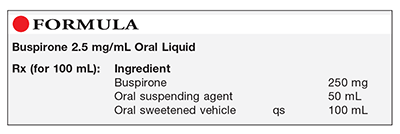US Pharm. 2015;40(11):58-59.

Method of Preparation: Calculate the quantity of each ingredient for the amount to be prepared. Accurately weigh or measure each ingredient or obtain the required number of buspirone tablets. Place the buspirone in a mortar; if tablets are used, pulverize them thoroughly in a mortar with a pestle. Slowly incorporate the oral suspending agent (Ora-Plus or similar) into the powder and mix well until uniform. Slowly add the oral sweetened vehicle (Ora-Sweet, Ora-Sweet SF, or similar) to final volume and mix well. Package and label.
Use: This preparation is an antianxiety agent used in the management of generalized anxiety disorder. It has also been used in the management of aggression in mental retardation and secondary mental disorders; major depression; and premenstrual syndrome, and as a potential augmenting agent for antidepressants.
Packaging: Package in tight, light-resistant containers.
Labeling: Keep out of reach of children. Keep refrigerated. Shake well. Discard after ____ [time period].
Stability: A beyond-use date of 14 days when stored in a refrigerator may be used.1
Quality Control: Quality-control assessment can include weight/volume, pH, specific gravity, active drug assay, color, rheologic properties/pourability, physical observation, and physical stability (discoloration, foreign materials, gas formation, mold growth).2
Discussion: Buspirone (BuSpar, Apo-Buspirone, Buspirex, C21H31N5O2.HCl, MW 421.96) is an anxiolytic agent used in the management of anxiety disorders and for short-term relief of anxiety symptoms. It occurs as a white, crystalline powder and has a solubility of ≥865 mg/mL in water and about 20 mg/mL in alcohol. Buspirone is commercially available as 5-, 7.5-, 10-, 15-, and 30-mg tablets. The tablets also contain the following inactive ingredients: colloidal silicon dioxide, lactose, magnesium stearate, microcrystalline cellulose, and sodium starch glycolate.3
Several oral suspending vehicles are commercially available; just two of them are mentioned here.
PCCA-Plus oral suspending vehicle is a convenient, pleasant-tasting vehicle for the suspension of insoluble substances. It is a preserved, buffered vehicle with demulcent qualities. PCCA-Plus has a neutral to slightly basic pH (6.9-7.5) and is thixotropic (viscosity approximately 1,000 cps). It contains purified water, carrageenan, simethicone, xanthan gum, microcrystalline cellulose, sodium carboxymethylcellulose, sodium phosphate dibasic, citric acid, potassium sorbate, methylparaben, and propylparaben.4
Ora-Plus is an oral suspending vehicle that accepts dilution of up to 50% or more with water, flavoring agents, or syrups and still retains its suspending properties. It has a pH of approximately 4.2 and an osmolality of about 230 mOsm/kg. Ora-Plus is a thixotropic vehicle with a viscosity of approximately 1,000 cps at 25°C. It contains purified water, microcrystalline cellulose, sodium carboxymethylcellulose, xanthan gum, carrageenan, sodium phosphate, and citric acid as buffering agents; simethicone as an antifoaming agent; and potassium sorbate and methylparaben as preservatives.5
Numerous sweetened (regular and sugar-free) oral liquid vehicles are available; only a few of them are discussed here.
Ora-Sweet syrup vehicle is a flavoring vehicle for oral extemporaneous preparations. It is flavored with a citrus-berry flavor blend and contains glycerin and sorbitol to prevent cap lock, a problem associated with many syrups. Ora-Sweet is buffered to a pH of approximately 4.2 and has an osmolality of about 3,240 mOsm/kg. It contains purified water, sucrose, glycerin, sorbitol (5%), flavoring, sodium phosphate, and citric acid as buffering agents and potassium sorbate and methylparaben as preservatives.6
PCCA Syrup Vehicle has a lesser percentage of sucrose than syrup does. It is also less viscous and is an excellent wetting vehicle.7
Ora-Sweet SF syrup vehicle is a flavoring vehicle for oral extemporaneous preparations. It is a sugar-free, alcohol-free syrup flavored with a citrus-berry flavor blend. Ora-Sweet SF is buffered to a pH of approximately 4.2. It will tolerate a dilution to 50% with dissolved actives in water or suspending agents and still retain an acceptable taste. Ora-Sweet SF has an osmolality of 2,150 mOsm/kg. It contains water, sodium saccharin, xanthan gum, glycerin, sorbitol, citric acid, and sodium citrate as buffers; methylparaben, propylparaben, and potassium sorbate as preservatives; and flavoring agents.8
PCCA Sweet-SF is a pleasant-tasting, sugar-free syrup vehicle for compounding soluble medications. This vehicle, which contains sorbitol, is able to mask many unpleasant tastes.9
Ready-to-use oral vehicles combining the suspending and sweetened vehicles (Ora-Blend, Ora-Blend SF, etc.) are also available.
REFERENCES
1. U.S. Pharmacopeia 38/National Formulary 33. Rockville, MD: U.S. Pharmacopeial Convention, Inc; 2014:559-611.
2. Allen LV Jr. Standard operating procedure for performing physical quality assessment of oral and topical liquids. IJPC. 1999;3:146-147.
3. McEvoy GK, ed. AHFS Drug Information 2012. Bethesda, MD: American Society of Health-System Pharmacists; 2012:2637-2643.
4. PCCA-Plus product information. Sugar Land, TX: PCCA; 2014.
5. Ora-Plus product information. Allegan, MI: Perrigo; 2014.
6. Ora-Sweet product information. Allegan, MI: Perrigo; 2014.
7. PCCA Syrup Vehicle product information. Sugar Land, TX: PCCA; 2014.
8. Ora-Sweet SF product information. Allegan, MI: Perrigo; 2014.
9. PCCA Sweet-SF product information. Sugar Land, TX: PCCA; 2014.
To comment on this article, contact rdavidson@uspharmacist.com.





